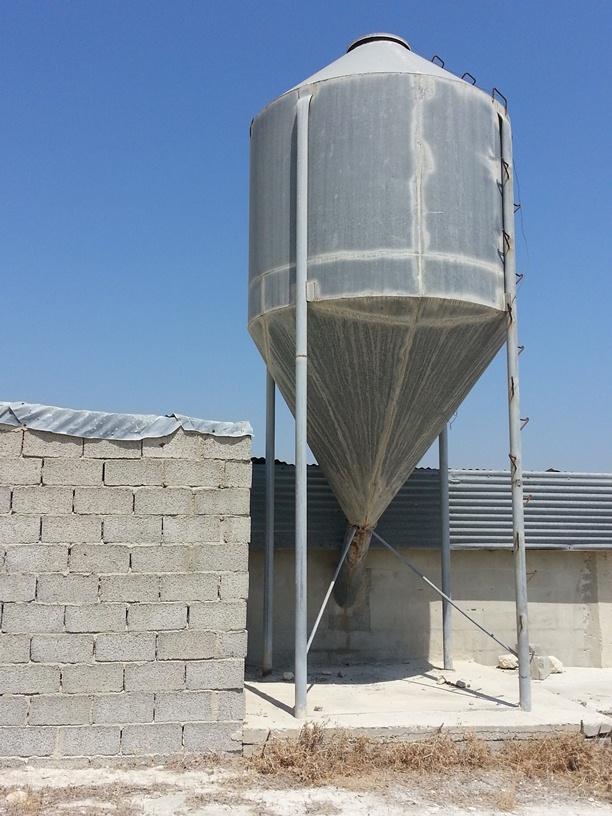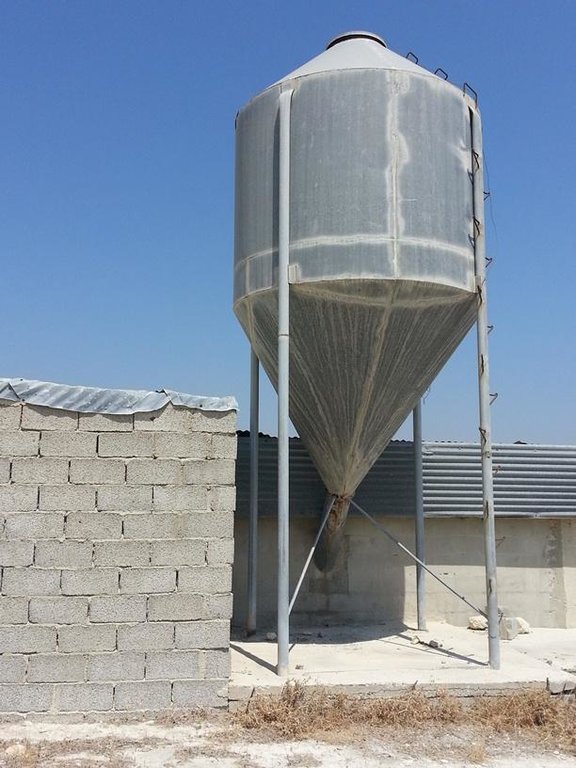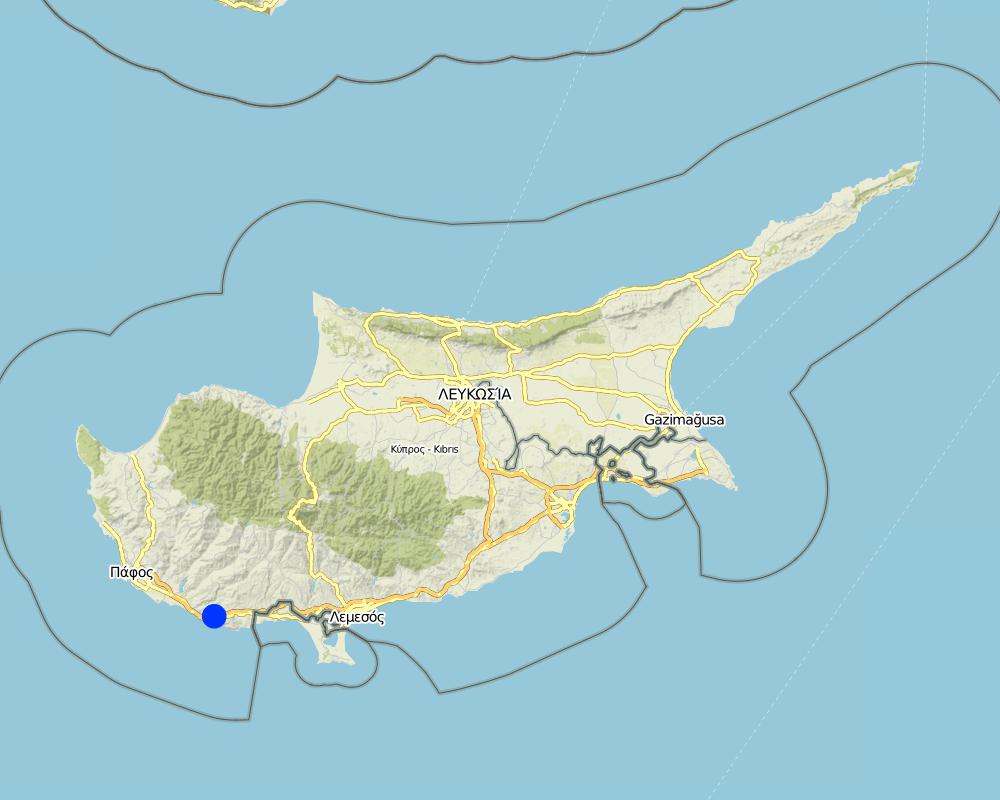Fodder provision to goats and sheep to reduce grazing pressure on natural vegetation [Cyprus]
- Creation:
- Update:
- Compiler: Michalakis Christoforou
- Editor: –
- Reviewers: Fabian Ottiger, Alexandra Gavilano
Παροχή σιτηρεσίου στα αιγοπρόβατα ως εναλλακτική τροφή με σκοπό τη μείωση της υπερβόσκησης στα φυσικά οικοσυστήμα(greek)
technologies_1247 - Cyprus
View sections
Expand all Collapse all1. General information
1.2 Contact details of resource persons and institutions involved in the assessment and documentation of the Technology
Name of project which facilitated the documentation/ evaluation of the Technology (if relevant)
Catastrophic shifts in drylands (EU-CASCADE)Name of the institution(s) which facilitated the documentation/ evaluation of the Technology (if relevant)
Cyprus University of Technology (Cyprus University of Technology) - Cyprus1.3 Conditions regarding the use of data documented through WOCAT
The compiler and key resource person(s) accept the conditions regarding the use of data documented through WOCAT:
Yes
2. Description of the SLM Technology
2.1 Short description of the Technology
Definition of the Technology:
Use of different types of fodder in order to reduce grazing impact on natural vegetation
2.2 Detailed description of the Technology
Description:
Goats graze on almost all plants even on thorny shrubs. The pastoralist in the past (some still do now a days) use to spread seeds on the grazing area in order to provide fodder for the animals. Another method is to provide fodder within the farm using dry seeds of wheat, barley, soya etc which can be stored in big silos.
Purpose of the Technology: The purpose of this technology is to provide to the animals with the food they need in order to minimize or even stop them from grazing on the wild flora such as shrubs, trees and annual plants. Within the study area, most of the vegetation is vanished and only traces of plant species can be found. Even the thorny shrubs like Callicotome villosa and Rhamnus oleiodes are suffering from overgrazing.
Establishment / maintenance activities and inputs: Fodder can be provided in-farm and out-farm. In-farm fodder is provided using a silo in which dry fodder can be store, mixed and deliver to the animals mechanically. Out-farm fodder is provided seasonally since the seeds should be seeded and plants must grow up before eaten by the animals
Natural / human environment: By providing fodder to the animals in-farm, grazing is avoided since the animals remain within the farm. This way, animal diseases transmission from one farm to another can be minimized. Also, animals may travel a long distance to find food whose energy miight be less than the energy they use.
Seeding on the hills will attract the goats and stop them from grazing on other wild plant species. Minimizing grazing will allow to the vegetation to recover and grow up providing good aesthetic view and also shelter for the wild animals. Furthermore, vegetation increase will contribute to the decrease of soil erosion and the increase of organic matter.
2.3 Photos of the Technology
2.5 Country/ region/ locations where the Technology has been applied and which are covered by this assessment
Country:
Cyprus
Region/ State/ Province:
Limassol
Further specification of location:
Pissouri
Specify the spread of the Technology:
- evenly spread over an area
If precise area is not known, indicate approximate area covered:
- 10-100 km2
Comments:
The total area in which goat and sheep farmer are allowed to grow animals is around 400 Km2. The area affected by overgrazing is around 100Km2
Map
×2.6 Date of implementation
If precise year is not known, indicate approximate date:
- less than 10 years ago (recently)
2.7 Introduction of the Technology
Specify how the Technology was introduced:
- through land users' innovation
Comments (type of project, etc.):
EU funding gave the opportunity to some new farmers to buy new equipment for fodder provision. In this way the new farmers were able to feed their animals and increase their productivity
3. Classification of the SLM Technology
3.2 Current land use type(s) where the Technology is applied
Land use mixed within the same land unit:
Yes
Specify mixed land use (crops/ grazing/ trees):
- Agro-pastoralism (incl. integrated crop-livestock)

Cropland
- Annual cropping
Number of growing seasons per year:
- 2
Specify:
Longest growing period in days: 120Longest growing period from month to month: March to JuneSecond longest growing period in days: 100Second longest growing period from month to month: September to December
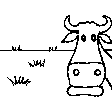
Grazing land
Extensive grazing:
- Semi-nomadic pastoralism
- Ranching
Animal type:
- goats
- sheep
Comments:
Major land use problems (compiler’s opinion): overgrazing due to a large amount of animals, drought, erosion
Major land use problems (land users’ perception): drought, poor calcareous soils, incomes are not enough to buy food
Semi-nomadism / pastoralism: goats/ rabbits, birds
Ranching: goats
Livestock density: > 100 LU /km2
Future (final) land use (after implementation of SLM Technology): Cropland: Ca: Annual cropping
3.3 Has land use changed due to the implementation of the Technology?
Has land use changed due to the implementation of the Technology?
- Yes (Please fill out the questions below with regard to the land use before implementation of the Technology)

Grazing land
- Extensive grazing
3.4 Water supply
Comments:
Water supply: rainfed, rainfed
3.5 SLM group to which the Technology belongs
- pastoralism and grazing land management
3.6 SLM measures comprising the Technology

agronomic measures
- A1: Vegetation/ soil cover
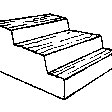
structural measures
- S11: Others
Comments:
Main measures: agronomic measures, structural measures
Specification of other structural measures: Use of Silos in order to provide fodder to the animals
Type of agronomic measures: mixed cropping / intercropping, legume inter-planting
3.7 Main types of land degradation addressed by the Technology

biological degradation
- Bc: reduction of vegetation cover
Comments:
Main type of degradation addressed: Bc: reduction of vegetation cover
Main causes of degradation: overgrazing (large number of animals), change in temperature (hot summers & cold winters force the animals to eat more in order to obtain water and energy from plants), change of seasonal rainfall (summers without rain and winters with some rain), droughts (heavy droughts every 3-4 years), poverty / wealth (farmers can not afford to feed the animals)
Secondary causes of degradation: deforestation / removal of natural vegetation (incl. forest fires) (about 90 years ago), urbanisation and infrastructure development (Urbanisation mostly at the coastal zone has forced the animals to move to the North. A large number of animals is concentrated in the northern site, increasing the overgrazing problem), inputs and infrastructure: (roads, markets, distribution of water points, other, …) (A highway road split the area in two), war and conflicts (In 1974 many refugees moved from the North to the South due to the invasion of Turkish troops. Most of them who established in the area became farmers, and therefore increased the number of animals)
3.8 Prevention, reduction, or restoration of land degradation
Specify the goal of the Technology with regard to land degradation:
- reduce land degradation
Comments:
Main goals: mitigation / reduction of land degradation
4. Technical specifications, implementation activities, inputs, and costs
4.1 Technical drawing of the Technology
Technical specifications (related to technical drawing):
Technical knowledge required for field staff / advisors: high (animal feeding specialist with good knowledge on goat and sheep fodder)
Technical knowledge required for land users: moderate (be able to follow the specialist advice and protocol for feeding animals)
Main technical functions: increase of biomass (quantity), promotion of vegetation species and varieties (quality, eg palatable fodder), control of animal feeding on natural vegetation
Mixed cropping / intercropping
Material/ species: cereal seeds (wheat, barley, etc)
Quantity/ density: 200kg/ha
Remarks: seeds should be seeded by hand during the rainy season
Legume inter-planting
Quantity/ density: 200kg/ha
Remarks: spread the seeds before the last rainfall in spring
Structural measure: Silo
Height of bunds/banks/others (m): 3
Width of bunds/banks/others (m): 1
Construction material (other): stainless steel
Specification of dams/ pans/ ponds: Capacity 9,42m3
4.2 General information regarding the calculation of inputs and costs
other/ national currency (specify):
euro
If relevant, indicate exchange rate from USD to local currency (e.g. 1 USD = 79.9 Brazilian Real): 1 USD =:
0.77
Indicate average wage cost of hired labour per day:
38.85
4.3 Establishment activities
| Activity | Timing (season) | |
|---|---|---|
| 1. | Buy or make a Silo | anytime |
| 2. | Buy cereal seeds (200kg) | |
| 3. | Buy legume seeds (200kg) |
Comments:
Inputs: Stainless steel
4.4 Costs and inputs needed for establishment
| Specify input | Unit | Quantity | Costs per Unit | Total costs per input | % of costs borne by land users | |
|---|---|---|---|---|---|---|
| Labour | Labour | ha | 1.0 | 116.0 | 116.0 | 100.0 |
| Equipment | Stainless steel silo | ha | 1.0 | 2589.0 | 2589.0 | 100.0 |
| Equipment | Fodder transfer tubes | ha | 1.0 | 1000.0 | 1000.0 | 100.0 |
| Plant material | Agricultural | ha | 1.0 | 427.0 | 427.0 | 100.0 |
| Total costs for establishment of the Technology | 4132.0 | |||||
| Total costs for establishment of the Technology in USD | 5366.23 | |||||
Comments:
Duration of establishment phase: 0.5 month(s)
Life-span of cereal seeds: 6 months
Life-span of legumes seeds: 3-4 months
4.5 Maintenance/ recurrent activities
| Activity | Timing/ frequency | |
|---|---|---|
| 1. | spreading seeds | during rainfall (oct - Mar) |
4.6 Costs and inputs needed for maintenance/ recurrent activities (per year)
| Specify input | Unit | Quantity | Costs per Unit | Total costs per input | % of costs borne by land users | |
|---|---|---|---|---|---|---|
| Labour | Labour | ha | 1.0 | 233.0 | 233.0 | 100.0 |
| Plant material | Seeds | ha | 1.0 | 427.0 | 427.0 | 100.0 |
| Total costs for maintenance of the Technology | 660.0 | |||||
| Total costs for maintenance of the Technology in USD | 857.14 | |||||
Comments:
Cost were calculated according to the farmers opinion which was confirmed by the agricultural department. Seeds and labor are calculated as units per ha and the silo per unit (farm)
4.7 Most important factors affecting the costs
Describe the most determinate factors affecting the costs:
Cost for applying fodder is affected by 3 factors: a) the price of the Silo which is applied only once, b) the cost of the seeds and c) the labor needed for spreading the seeds. The slope in the area where the technology is applied is steep and makes the seeding difficult.
5. Natural and human environment
5.1 Climate
Annual rainfall
- < 250 mm
- 251-500 mm
- 501-750 mm
- 751-1,000 mm
- 1,001-1,500 mm
- 1,501-2,000 mm
- 2,001-3,000 mm
- 3,001-4,000 mm
- > 4,000 mm
Specifications/ comments on rainfall:
Annual rainfall for the year 2013 was 207 mm. From june to october rainfall was 0. In the last three years annual rainfall was between 207 and 540 mm
Agro-climatic zone
- semi-arid
- arid
Thermal climate class: tropics. Winter 0-25 °C, and Summer 20-45 °C
Thermal climate class: subtropics. During the winter, mean temperature can be 15-18 °C
According to the FAO, Cyprus is considered to be an arid to semi-arid area
5.2 Topography
Slopes on average:
- flat (0-2%)
- gentle (3-5%)
- moderate (6-10%)
- rolling (11-15%)
- hilly (16-30%)
- steep (31-60%)
- very steep (>60%)
Landforms:
- plateau/plains
- ridges
- mountain slopes
- hill slopes
- footslopes
- valley floors
Altitudinal zone:
- 0-100 m a.s.l.
- 101-500 m a.s.l.
- 501-1,000 m a.s.l.
- 1,001-1,500 m a.s.l.
- 1,501-2,000 m a.s.l.
- 2,001-2,500 m a.s.l.
- 2,501-3,000 m a.s.l.
- 3,001-4,000 m a.s.l.
- > 4,000 m a.s.l.
Comments and further specifications on topography:
Altitudinal zone: 100-500 m a.s.l (The area where the technology is applied is 1km far from the sea)
Landforms: Hill slopes (The area of interest consists of steep hill slopes)
Slopes on average are rolling (most common) and hilly (sometimes after soil erosion)
5.3 Soils
Soil depth on average:
- very shallow (0-20 cm)
- shallow (21-50 cm)
- moderately deep (51-80 cm)
- deep (81-120 cm)
- very deep (> 120 cm)
Soil texture (topsoil):
- coarse/ light (sandy)
Topsoil organic matter:
- medium (1-3%)
If available, attach full soil description or specify the available information, e.g. soil type, soil PH/ acidity, Cation Exchange Capacity, nitrogen, salinity etc.
Soil depth on average is very shallow (the area is considered to be rocky) to shallow (only where soil is concentrated)
Soil texture is coarse (Analysis has shown that soil texture is 50% sand, 25% silt and 25% Clay)
Soil fertility is low
Topsoil organic matter is medium where some vegetation is, low where no vegetation is and high where vegetation is
Soil drainage/infiltration is poor (inter patch), medium (patch-interpatch) or good (plant patch)
Soil water storage capacity is low-medium
5.4 Water availability and quality
Availability of surface water:
poor/ none
Comments and further specifications on water quality and quantity:
Availability of surface water is poor/none (there is no surface water available in the area)
5.5 Biodiversity
Species diversity:
- low
Comments and further specifications on biodiversity:
Thorny shrubs, olive and carob trees, annual grass
5.6 Characteristics of land users applying the Technology
Off-farm income:
- 10-50% of all income
Relative level of wealth:
- poor
- average
Individuals or groups:
- individual/ household
Gender:
- women
- men
Indicate other relevant characteristics of the land users:
Land users applying the Technology are mainly Leaders / privileged
Difference in the involvement of women and men: no young women are involved with goat farming
Population density: 10-50 persons/km2
Annual population growth: negative
10% of the land users are average wealthy and own 10% of the land (they make profit).
10% of the land users are poor and own 5% of the land (they barely survive).
Off-farm income specification: Some of the pastoralists who apply the SLM technology, have apartments which they rent to tourists during the summer season
Market orientation of production system: Equipment and structure subsidy (50% of the equipment and structures are funded)
Market orientation: Mixed (subsistence and commercial): Pastoralists receive subsidy from EU funds annually
5.7 Average area of land used by land users applying the Technology
- < 0.5 ha
- 0.5-1 ha
- 1-2 ha
- 2-5 ha
- 5-15 ha
- 15-50 ha
- 50-100 ha
- 100-500 ha
- 500-1,000 ha
- 1,000-10,000 ha
- > 10,000 ha
Is this considered small-, medium- or large-scale (referring to local context)?
- large-scale
Comments:
The animal numbers are 10 times the amount permitted to graze in the area
5.8 Land ownership, land use rights, and water use rights
Land ownership:
- state
Land use rights:
- open access (unorganized)
- individual
Comments:
More than 70% of the land belongs to the government (forestry department) and the land is open to everybody. The pastoralists do not pay rent for using the land. The land which belongs to individuals is used by the owners or is been rented to the pastoralists
5.9 Access to services and infrastructure
health:
- poor
- moderate
- good
education:
- poor
- moderate
- good
technical assistance:
- poor
- moderate
- good
employment (e.g. off-farm):
- poor
- moderate
- good
markets:
- poor
- moderate
- good
energy:
- poor
- moderate
- good
roads and transport:
- poor
- moderate
- good
drinking water and sanitation:
- poor
- moderate
- good
financial services:
- poor
- moderate
- good
6. Impacts and concluding statements
6.1 On-site impacts the Technology has shown
Socio-economic impacts
Production
fodder production
Comments/ specify:
Spreading cereals and legumes
animal production
Comments/ specify:
By providing fodder all year round
risk of production failure
Comments/ specify:
By providing fodder all year round
product diversity
Comments/ specify:
Better quality of dairy products
land management
Income and costs
expenses on agricultural inputs
Comments/ specify:
During the first year, the cost of the Silo
farm income
Comments/ specify:
Due to production increase
workload
Comments/ specify:
In-farm fodder provision. Labor hours are reduced due to the presence of fodder in the silo. Simplified farm operations through using the silo.
Socio-cultural impacts
food security/ self-sufficiency
Comments/ specify:
Animals from different farms are no more in contact
SLM/ land degradation knowledge
Comments/ specify:
Seeding on the hill reduces erosion
conflict mitigation
Comments/ specify:
Between pastoralists
Improved livelihoods and human well-being
Comments/ specify:
Shepherds who provide fodder and/or are seeding cereals and legumes on grazing land, produce more milk and meat. Therefore, they have higher incomes and a better life. They are able to send their children to school and provide a health care insurance to their families.
Ecological impacts
Water cycle/ runoff
surface runoff
Comments/ specify:
Due to vegetation cover
evaporation
Comments/ specify:
Due to vegetation cover
Soil
soil moisture
Comments/ specify:
Due to vegetation cover
soil cover
soil loss
Comments/ specify:
Due to soil cover by cereals and legumes
Biodiversity: vegetation, animals
plant diversity
Comments/ specify:
May be in the near future, antagonism between cereals and legumes with other wild type species will appear
animal diversity
Comments/ specify:
Especially birds
6.2 Off-site impacts the Technology has shown
damage on neighbours' fields
Comments/ specify:
On site since the animals will graze in the seeded area
damage on public/ private infrastructure
Comments/ specify:
On site since the animals will graze in the seeded area
6.3 Exposure and sensitivity of the Technology to gradual climate change and climate-related extremes/ disasters (as perceived by land users)
Gradual climate change
Gradual climate change
| Season | increase or decrease | How does the Technology cope with it? | |
|---|---|---|---|
| annual temperature | increase | not well |
Climate-related extremes (disasters)
Meteorological disasters
| How does the Technology cope with it? | |
|---|---|
| local rainstorm | well |
| local windstorm | not known |
Climatological disasters
| How does the Technology cope with it? | |
|---|---|
| drought | not well |
Hydrological disasters
| How does the Technology cope with it? | |
|---|---|
| general (river) flood | not known |
Other climate-related consequences
Other climate-related consequences
| How does the Technology cope with it? | |
|---|---|
| reduced growing period | not known |
6.4 Cost-benefit analysis
How do the benefits compare with the establishment costs (from land users’ perspective)?
Short-term returns:
very negative
Long-term returns:
slightly positive
How do the benefits compare with the maintenance/ recurrent costs (from land users' perspective)?
Short-term returns:
neutral/ balanced
Long-term returns:
slightly positive
Comments:
Shepherds who apply the technology and are in a better socio-economical status are satisfied with their incomes but they believe that things could get better. Shepherds who don't apply the technology are poor, not satisfied with the incomes they receive and at the same time they are negative in applying the technology although they see other shepherds being in a better socio-economic status than them.
6.5 Adoption of the Technology
Comments:
100% of land user families have adopted the Technology with external material support
2 land user families have adopted the Technology with external material support
Comments on acceptance with external material support: New farmers-shepherds can have up to 60% funding from EU and government funds for construction and equipment
There is no trend towards spontaneous adoption of the Technology
Comments on adoption trend: The cost of buying fodder is extremely high. Also the equipments (silo) is considered to be expensive.
6.7 Strengths/ advantages/ opportunities of the Technology
| Strengths/ advantages/ opportunities in the land user’s view |
|---|
| Using the Silo for providing fodder, they spend less hours in the farm. |
| By providing fodder, the quality and quantity of milk and meat is better |
| By keeping the animals in the farm, they save work hours and also the threat of animal poisoning is minimized |
| Strengths/ advantages/ opportunities in the compiler’s or other key resource person’s view |
|---|
|
By providing fodder in and out of the farm the animals receive a better quality of fodder and the right quantities of fodder they need. How can they be sustained / enhanced? experts can give advices to the shepherds about the type of fodder, and the quantity during different seasons |
|
Through grazing in a specific area marked and seeded by the shepherd, the animals avoid direct contact with other animals. This minimizes the spread of diseases between animals of different farms. How can they be sustained / enhanced? Shepherds should come to an agreement about the area their animals graze and create borders |
|
Seeding cereals and legumes within the grazing areas decreases overgrazing on shrubs and annual plants How can they be sustained / enhanced? in the case where the shepherd is leading the animals, he should not allow the animals to graze on shrubs |
|
The presence of a Silo in a farm makes fodder provision easier and therefore less work is required How can they be sustained / enhanced? Government funding can cover the cost of the silo |
| seeding in the grazing area leads to improved soil cover which minimizes soil erosion |
6.8 Weaknesses/ disadvantages/ risks of the Technology and ways of overcoming them
| Weaknesses/ disadvantages/ risks in the land user’s view | How can they be overcome? |
|---|---|
| It is difficult to spread seeds on the rocky hills | |
| Buying fodder is expensive |
| Weaknesses/ disadvantages/ risks in the compiler’s or other key resource person’s view | How can they be overcome? |
|---|---|
| Not all shepherd are able to buy the Silo and large amounts of fodder to store in the silo | Government funding can cover the cost of the silo |
| The Randi forest area is suffering from prolonged droughts. Seeding cereals in the grazing land will not be achieved without rain. |
7. References and links
7.1 Methods/ sources of information
Links and modules
Expand all Collapse allLinks
No links
Modules
No modules


